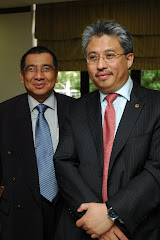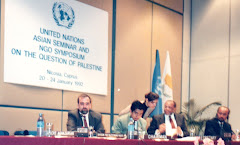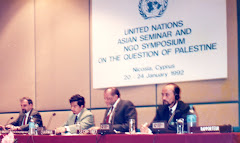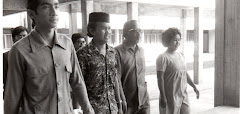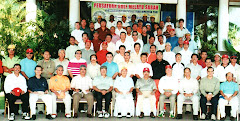ETP – COMMEMORATING THREE YEARS OF
IMPLEMENTATION
Ladies and Gentlemen,
When I received the mandate as Prime
Minister in 2009, I was faced with the challenging, if not daunting task to
deliver on Vision 2020. Since 2000,
Malaysia was mired in economic uncertainty as the country struggled to recover
from three successive waves of global economic crises. On the home front, the
Global Financial Crisis of 2008 adversely affected the economy as GDP growth
contracted by 1.5 percent.
Caught between this tough scenario and
the collective national aspiration to become a high income advanced nation by
2020, the only way forward was to transform the economy through bold and
radical change, speedy decision-making and swift execution.
Hence, the Economic Transformation
Programme. Designed with a very specific objective of bringing Malaysia to
high-income status by 2020, our true north goals are clear, that is, to attain
a GNI per capita of USD15,000, create 3.3 million additional jobs and attract
USD444 billion worth of investments.
Ladies and Gentlemen,
The ETP has dual objectives. It leverages
on 12 targeted economic growth sectors. These 12 National Key Economic Areas or
NKEAs have been earmarked to boost awareness of the most attractive economic
prospects for potential investors in our economy. Through the six Strategic
Reform Initiatives, policies and procedures have been put in place for
businesses to compete and flourish.
The last three years have been a
watershed period for the government. We have battled global headwinds and
searing competition from ASEAN and the emerging markets. We have ramped up
efforts to deliver our promises to the country and I must say we have been
successful in bringing together the government and private sector to deliver
results.
Let me give you some details. GNI per
capita from 2009 to 2012 has steadily increased hitting USD9, 928 in 2012.
Barring major unforeseen disruptions and based on the current growth
trajectory, we are on track to achieve high-income status by 2020 if not
earlier.
Despite the challenge of a slower global
economic recovery, Malaysia’s real GDP grew from RM676.7 billion in 2010 to
RM751.5 billion in 2012. This represents a significant increase of 11 percent.
As of quarter three this year, GDP recorded a five percent increase
year-on-year, outstripping forecasts. It is projected to hit 4.5 to five
percent by year-end.
Ladies and Gentlemen,
I am especially pleased to say that the
country is officially at full employment, with declining unemployment rates
from 3.7 percent in 2009 to three percent in 2012. During my tenure, employment
has increased by 1.8 million, as population growth held steady at 1.7 percent.
Meanwhile, we have tripled the annual
growth rate of private investment since the start of the economic
transformation in 2010. The baseline average of five percent a year from 2008
to 2010 has been lifted three-fold to 16 percent for the period 2010 to 2012.
This year, private investment is forecast to grow at 16.2 percent, hitting
RM135.8 billion.
This upward trend is testament to
growing private sector confidence in our transformation initiatives, as
evidenced by the widening gap between private and public investments. Private
investment accounted for 65 percent of total investment in the first nine
months of this year.
In addition, moving toward the revenue
structure of a developed economy, we are not only becoming more efficient in
our tax collection but are also broadening the tax base. This is important
because strengthened revenue puts us in a better position to sustainably
administer socioeconomic programmes geared towards narrowing income disparity.
The results as you can see are an increase in government revenue of 14 percent
for the period of 2010 to 2012, growing from RM160 billion to RM207 billion. We
project to hit RM220 billion in revenue this year.
One aspect that gives me great
satisfaction is our performance in reducing fiscal deficit. Where many
governments fail to deliver, Malaysia by contrast, is strongly on track to a
balanced budget by 2020. We continue to slash back our fiscal deficit as a
percentage of GDP. From 6.6 percent in 2009, we will reach four percent this
year, and further reduce the deficit to three percent in 2015.
Private consumption is spurred by
growing consumer confidence, supported by stable employment and higher wage
growth especially in the domestic sector. Private consumption held steady since
2010, growing from six percent to 7.7 percent in 2012. In the first nine months
alone this year, we grew at 7.7 percent.
Investors showed confidence in the
Malaysian stock market, as can be seen by the FTSE-KLCI’s upward trend, hitting
66 historical highs in the last three years. On 10 December 2013, the market
scaled another record high at 1,843.85 points.
Independent global agencies have also
recognized the improvements we have made. In the World Bank Ease of Doing
Business Index we have climbed steadily from the 18th position, to 12th and we
recently catapulted to sixth position in 2014, surpassing the UK for the first
time. This reflects real improvement to the business environment, and my commendation
goes out to the dedicated efforts of Pemudah, Pemandu, MITI and MIDA.
Ladies and Gentlemen,
This year alone, significant investments
have been committed by businesses and facilitated by the various agencies.
MIDA’s first nine months saw RM137 billion worth of investments from 3,908
projects, creating 127,000 jobs. Meanwhile, the Corridors as drivers of
regional growth have launched new projects, with committed investments of
RM53.4 billion. These are impressive numbers thanks to the tireless work from
the various teams driving investments and growth and kudos to all!
Among the many projects that come to my
attention, I am particularly moved when private and public sectors collaborate
to bring real results to the very heart of local communities. As an example,
local dairy farmers in Johor, with the help of private companies and government
agencies, successfully increased their productivity levels by 50 percent.
Consequently, they have upped their selling price by 50 percent from RM1.70 per
litre of milk to RM2.40, contributing directly to their household income.
We also see a similar improvement for
our ‘rice bowl’ in Muda, covering 15,000 hectares in the northern region of
Kedah and Perlis. The farmers are now enjoying a 12 percent increase in their
overall income from paddy farming activities, as a result of centralized
management, improved irrigation infrastructure and farming techniques.
In urban development, we will see
Malaysian wholesale and retail operations catching up to the trend of
integrated mega-retail, which is characteristic of the developed consumer
markets. Known as the “Big Box Boulevard”
projects, an example is the upcoming connected multi-theme retail components in
Ara Damansara. Developed by Sime Darby Brunsfield Group to meet Malaysia’s
growing demand for large-scale retail experience, this project is expected to
exceed RM 1.5 billion in investment, creating 2,409 jobs.
On a larger front, Petronas has recently
awarded RM10 billion worth of service contracts to six local service providers,
recognizing the capabilities of local service providers including Bumiputera
companies.
I have asked MIDA, MITI, Pemandu and the
Corridor Authorities to work together to drive and monitor investments in
Malaysia. MIDA was re-designated from the Malaysian Industrial Development
Authority to the Malaysian Investment Development Authority, to be the first
port of call for investments into Malaysia.
In order to secure a strong investment
portfolio for the country, it is imperative that the various agencies
collaborate together. I have asked Dato’ Seri Mustapa Mohamed, Dato' Sri Idris
Jala and the Corridor Authorities to work together, to institute a discipline
of action by placing these projects – where relevant – directly under their
monthly Steering Committees. These projects will be rigorously monitored to
ensure successful implementation and results.
Ladies and Gentlement,
Coming back to the ETP, our overall KPI
results for NKEAs are on track with 89 percent achieved on average, while the
Strategic Reform Initiatives recorded 85 percent of KPI achieved. This
demonstrates that both projects and initiatives are tracking well and I am confident
of meeting our targets this year.
The NKEAs continue to play a significant
role in the national economy, contributing 68.3 percent of total GNI for the
first nine months of this year, or RM474 billion.
The NKEAs have also contributed to
employment, with 1.3 million in new employments recorded from 2010 to 2013
year-to-date. Currently total employment sits at 13.66 million.
While our committed investment figures
are optimistic, the real challenge is in realizing these investments. It is
heartening to see that 69 percent of the amount committed for 2013 has been
realized as of the third quarter. The NKEAs are on target to mirror their
achievements of the previous two years.
As we conclude 2013 and take stock of
the three years of the country’s economic transformation, I am happy to
announce that 195 projects have been launched under the NKEAs since 2010. Their
total committed investments of RM220 billion are projected to contribute RM144
billion to GNI, create 435,000 new jobs, and generate a knock-on effect that
will catalyse the larger universe of economic activity in the country.
The global outlook continues to be
uncertain as developed markets grapple with their challenges. Despite this,
Malaysia is targeted to achieve between five to 5.5 percent GDP growth for
2014, with private investment expected to grow 12.7 percent to RM153 billion.
For 2014, Malaysia will see exciting
developments in the pipeline, in support of our pursuit to become the center
for global operations, services and trading. We have set our sights on
attracting 13 large multinationals to base their operations here in Kuala
Lumpur. Six international trading companies, with a projected minimum of total
turnover of USD600 million, will potentially establish their trading operations
in the country. In the financial markets, we are set to see an increased value
in new listings, with a targeted market capitalization of RM18 billion.
Ladies and Gentlemen,
I am very glad to see all of you here,
representing the business and investment community. We welcome your continued
support as we move into 2014. It is my wish that everyone, rich or poor, rural
or urban, regardless of race, can participate in the journey to transform the
economy and take the country to high-income.
I wish all of you Seasons Greetings and
a very happy New Year.


































